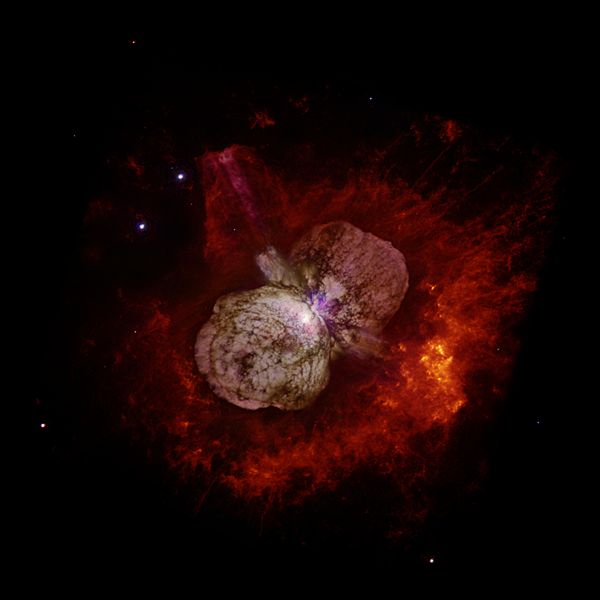BY LETTER
Eta Carinae
Galactography > Regions of Space > Periphery
Galactography > Places and Locales
Galactography > Systems and Worlds > Systems & Worlds E - F
Galactography > Places and Locales
Galactography > Systems and Worlds > Systems & Worlds E - F
 Image from Steve Bowers |
Star: Eta Carina A/B
Combined Luminosity: (variable) 1 to 5 million x Sol
Type: Luminous Blue Variable (Eta Carinae A) and O-type supergiant star (Eta Carinae B)
Distance from Sol: 9,453 ly; galactic xyz coordinates 2858 -9010 -103
A binary star system comprising of a peculiar, erratically fluctuating Luminous Blue Variable and an O-type supergiant star. One of the most luminous stellar objects of our Galaxy. The interaction between the two stars and their stellar winds cause wild fluctuations in their combined UV and X-Ray emissions. Sometimes Eta Carina is easily visible from the Inner Sphere, even with baseline human eyes; at other times it is much less bright. The star is located in the Carina OB1 stellar association, and is surrounded by the Homunculus Nebula, which has changed shape many times in the last 10 thousand years since it was first observed.
Fast explorer class probe ships are currently en route to the star, and the first of these have almost certainly arrived; however the confirmation message from the lead vessels has not arrived back in the Terragen Sphere yet. Long distance observation of this beacon star suggests that there are a number of quite advanced xenosophont vessels present in this location, possibly from MEEC-MW-1 or another less well-known civilisation. These vessels are probably studying the star in anticipation of its explosion as a supernova, likely to happen in the next two thousand years (depending on frame of reference).
The two stars are surrounded by the Eta Carinae nebula (NGC 3372), a huge diffuse emission nebula consisting of clouds of high temperature gas some 9,000 light years from Sol. The atoms in the cloud are energized by ultraviolet light from nearby stars and emit radiation as they fall back into lower energy states (in much the same way as a neon light). It is a site of ongoing star formation. Each of the bright lobes are the size of an entire solar system. A whole mythology and economy has built up around this beautiful nebula, the so-called Carina Rush.
Related Articles
Appears in Topics
Development Notes
Text by Chris Clowes
Updated by Steve Bowers
Initially published on 24 October 2001.
Updated by Steve Bowers
Initially published on 24 October 2001.







